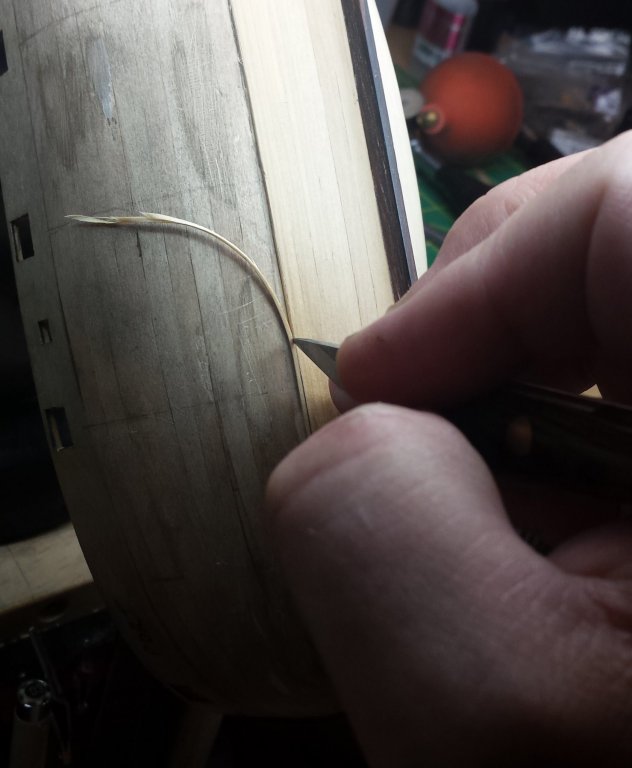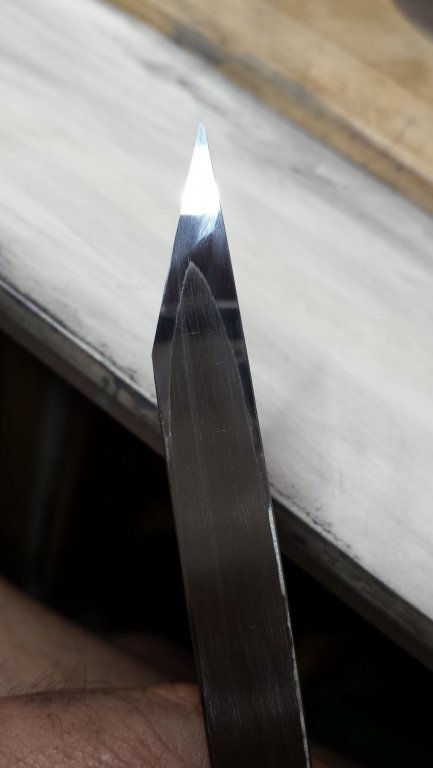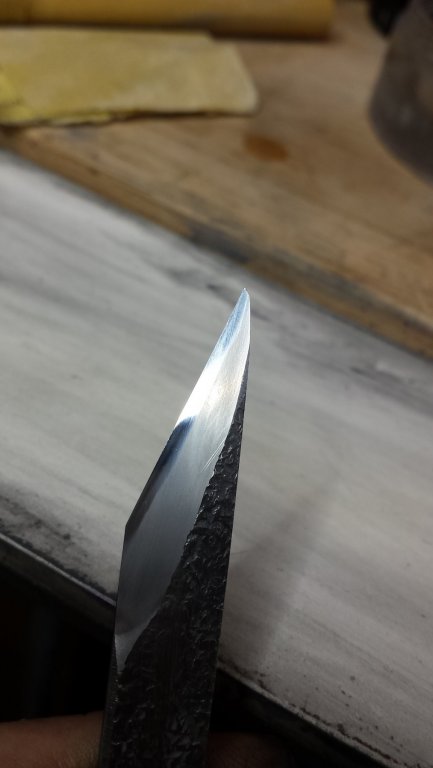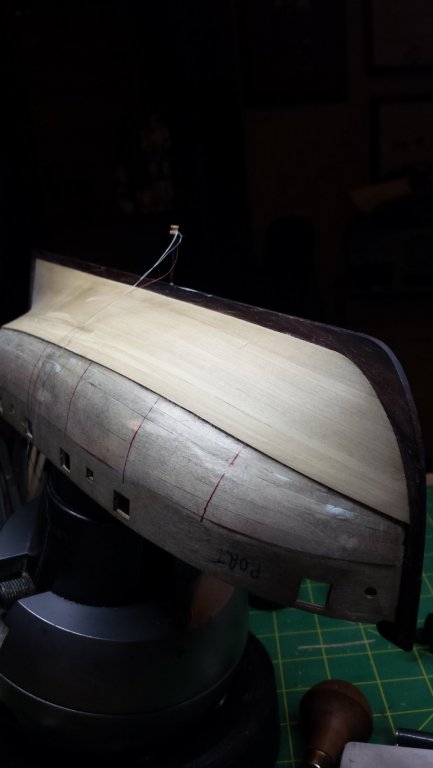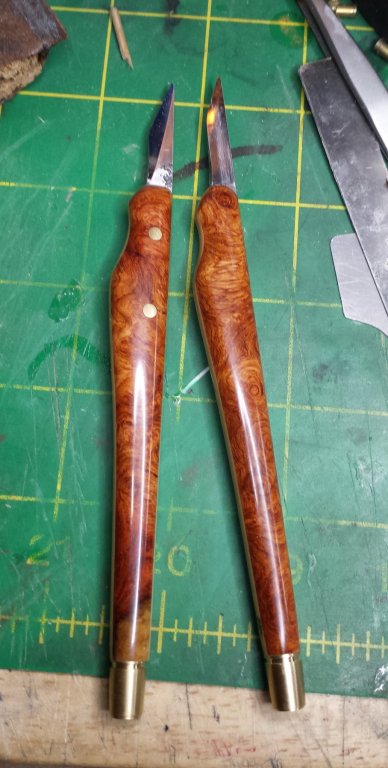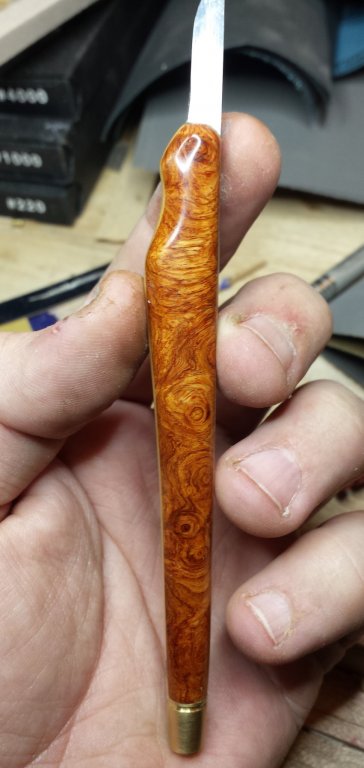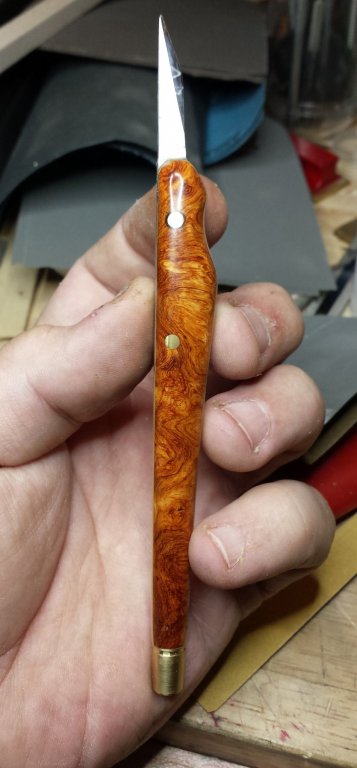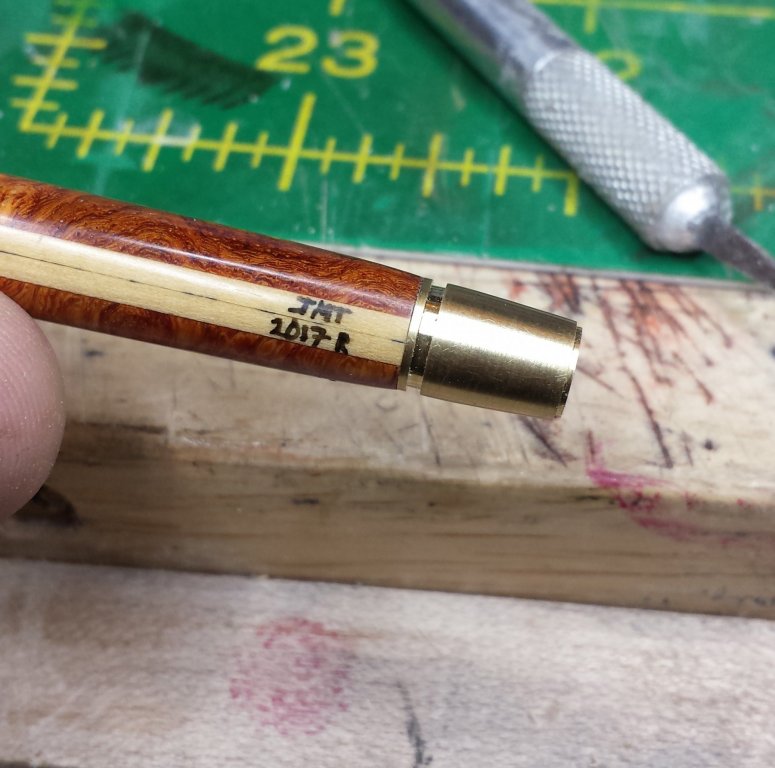-
Posts
1,477 -
Joined
-
Last visited
Content Type
Profiles
Forums
Gallery
Events
Everything posted by vossiewulf
-
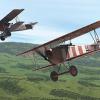
MONTAÑES by Amalio
vossiewulf replied to Amalio's topic in - Build logs for subjects built 1751 - 1800
I've been sitting looking at the capstan and trying to figure out how I'd make it, and all the paths require a lathe and milling machine and rotary table with tailstock and indexing head and possibly custom tapered mills. And at least several complex jigs, most of which would be single use, they'd be made specifically for that capstan. If you're able to do that with only simple tools I'm coming all the way to Spain just to kick you in the shin for being that good. He estado sentado mirando el cabrestante y tratando de encontrar la manera que lo lograría, y todos los caminos requieren un torno y fresadora y una mesa giratoria con el contrapunto y la cabeza indexación y posiblemente molinos cónicos personalizado. Y al menos varias plantillas complejas, la mayor parte de lo que sería de un solo uso, estarían hechas específicamente para ese cabrestante. Si usted es capaz de hacer eso con sólo herramientas simples que estoy procedentes de todo el camino a España sólo para dar una patada en la espinilla por ser tan bueno. -

MONTAÑES by Amalio
vossiewulf replied to Amalio's topic in - Build logs for subjects built 1751 - 1800
Ok after that capstan I'm back to thinking we need to check for alien DNA. That's really not easy to make and it's completely perfect. -
What, this isn't Model Knife World? Who knew? I used them briefly officially for first time a little while ago, they work exactly as expected. But I've been sick since Friday, very unusual for me to be sick more than a couple days, finally broke down and am going to doctor in morning just for being sick for the first time in about 25 years. But only because I have a cough that's bad enough to potentially be bacterial. Anyway haven't gotten much done since finishing the knives.
- 714 replies
-
- lady nelson
- victory models
-
(and 1 more)
Tagged with:
-
Nice job on the presentation Danny. I'm putting you in the same file with Popeye, if you're working I'm staying out of arms reach, there's whirling arms and saws and glue and paint in there.
- 193 replies
-
- cerberus
- paper shipwright
-
(and 1 more)
Tagged with:
-

More tools - Luthier, jeweler, fly-tying
vossiewulf replied to vossiewulf's topic in Modeling tools and Workshop Equipment
Thanks CDW! Hopefully people see that nothing I did should be beyond a decently-equipped shipbuilder's workshop, at least to create a basic knife - the brass balance pieces I make for my knives are in no way required, so no need for a lathe for someone to make a knife for themselves. The wood part everyone here should be able to make easily, and the finish is just thin CA glue that we all have on our benches. That was the purpose of documenting making making those, to show people that if you have a bench grinder and standard ship modeler tools and equipment, you can do it too and in most cases make something much better than you can buy for maybe $10-$20 in materials. I know I can make a pretty knife if I want to, I don't need a bunch of pics to remind me -

More tools - Luthier, jeweler, fly-tying
vossiewulf replied to vossiewulf's topic in Modeling tools and Workshop Equipment
Thanks Michael! -
Welcome. It's not perfect but it works well for some images. If that doesn't work, you can try the Warp option under Transform, it's the most powerful but as with everything in computers that gets that label, that also means it's hard to control. You have four moveable control points on the corners, plus they each have two bezier control points that can be also be used to stretch the outer edges of your selection. Then you can also click anywhere within the selected area and click and drag to move the contents around and other areas with get squished or stretched to compensate. One trick with all of these (that really need a "strength" setting) to attenuate the effects is to select an area bigger than that you want to alter. So if you have a drawing you can increase the size of the canvas and then select an area bigger than the drawing itself and that will make the effects of dragging transform control points less dramatic.
- 2,696 replies
-
- heller
- soleil royal
-
(and 9 more)
Tagged with:
-
Nah I think it would be the exact opposite, no real ship to match or plans to figure out, sketch out something for yourself, maybe buy a couple cheap rocket kits for parts, and build whatever comes to your mind when you think of a flying sailing ship as imagine by H.G. Wells
- 453 replies
-
- thermopylae
- sergal
-
(and 1 more)
Tagged with:
-

More tools - Luthier, jeweler, fly-tying
vossiewulf replied to vossiewulf's topic in Modeling tools and Workshop Equipment
For anyone who has ever considered making their own knives with custom blade shapes, I just did this and the full walkthrough on how I did is in my build log starting here. I decided I wanted paired single-bevel knives for employment in the planking method I'm using; I have lots and lots of experience using knives for precision purposes. That said, if you like my planking results you can use the same method without doing the trimming via knife the way I do it, or at least not use them to trim quite as close to the mark as I do. Single-bevel knives for me immediately bring to mind Japanese marking knives. In traditional Japanese joinery these make not just a mark to cut to, their "marks" are actually the visible edge of the joint. So they are made single-bevel with the perfectly-flat back of the knife going against the ruler with the bevel facing the waste part that will be removed, and they are made in pairs so you can make the proper marks in both directions if needed. And as is usual for Japanese knives, there is only a thin strip of very high-carbon cutting edge steel that is welded to very low-carbon steel or in some cases even plain iron to provide flexibility, and as a result the cutting edge steel can be extremely hard, typically Rc63-64. And that means they can be made extremely sharp and the edge will hold for a long time. So I bought a pair of 1/2" wide marking knives from Japan Woodworker, I knew the steel quality would be very good even on a mid-price marking knife, and they were $22 each. If you follow the tutorial also, you'll see I ended up cutting them in half as I didn't need the full length for the final knives, so in effect I'm going to get two knives out of each of those $22 blades. Blanks for the handles can be easily had by buying pen blanks use by pen makers, and you can get extremely nice wood for this purpose for $5-$10. In my case I used a single $10 amboyna burl piece glued to 1/16" castello boxwood sheet pieces to provide extra strength - you'll want to do something similar if you go with burl wood for the outer handle parts as all burl wood is inherently weak with lots of short grain no matter which way you cut it. I also mitigate that weakness by soaking the handles for an hour at least in thin CA glue, which penetrates deeply and turns the whole thing into a composite material with considerable strength. This is how I will be using the knives, one for each cutting direction to ensure the cut on the work side leaves a perfectly flat and vertical surface for the next plank (after a bit of sanding to finalize) - the method I'm using is to do the taper and beveling one the plank is already glued on the ship. And this is the result so far. In any case, this is what I started with - And that was a mistake, at least on the width - I bought 1/2" knives when I really needed no more than 1/4". This led to lots of grinding I shouldn't have needed to do. And this is the final result, a pair of amboyna burl pen-handled single bevel knives that I will be using from this point forward for all planking jobs. -
Thanks guys. No Popeye, unless it was sudden onset as I've had that in my face since I started using Zap a Gap in like 1988? Pat, I'm very please with blade shape and handle shape. The taper of the blade from the top view makes it nice and thin and low cutting resistance at tip, and my hand really likes the new handle design, super secure and stable.
- 714 replies
-
- lady nelson
- victory models
-
(and 1 more)
Tagged with:
-
Been really sick last couple days. But just need to resharpen these and off we go. Second knife. I wish I could find a pen with a really fine line, most of these will make a fine line on paper and nothing else.
- 714 replies
-
- lady nelson
- victory models
-
(and 1 more)
Tagged with:
-

Fokker Dr.I by Torbogdan - FINISHED - Model Airways
vossiewulf replied to Torbogdan's topic in Non-ship/categorised builds
Oh yeah the consensus at the time was the French-built engines were better so it wasn't uncommon to replace a UR.II with a Le Rhone on Dr.Is. Josef Jacobs is the only one I'm aware of that mounted a Clerget on a Dr.I. The problem wasn't just the quality of the engine build however, it was the oil, the Germans ran short of castor oil and tried all sorts of ersatz products with little success, and the engines suffered as a result. Actually if there was a severe failure by the German air industry, it was in engine development, they fell behind in 1916 and were falling farther behind at the end of the war with the allies fielding multiple fighter aircraft with 220+hp engines, with the Dolphin having a 300hp engine, while the "fast" version of Germany's top front-line fighter, the D.VII was flying with a 180hp BMW IIIa and the Albatros D.Vas were mostly still flying with the Mercedes D.III(a or au) most still developing 165hp but the aus could push it up to 185hp. Actually the Albatros D.V is a very good example, because meanwhile the Austrians had turned the earlier Albatros D.III they licensed into a MUCH better fighter than either the D.III or D.V versions the Germans flew, except for the absurd Schwarsloze MGs. Oeffag, the Austrian manufacturer, immediately realized the problem with the single spar lower wing leading to resonance and the resultant loss of the lower wing. After a bunch of German pilots were killed Albatros slapped a short strut from the wing V-strut to the lower wing leading edge which helped, but the German Albatrosen were never good divers, you could only push that lower wing so far. The Oeffag engineers instead redsigned the lower wing with two spars, redesigned the lower part of the v-struts and their mounting, and the OEF aircraft never had that resonance and could be dived much harder. The lowest hp engines the Austrians used was the 185hp Daimler-Benz, the other two Albatros series they built had the 200hp and 225hp Daimler-Benz engines. Then they realized the plane was faster without its spinner, something that wasn't too hard to verify since the one thing OEF engineers couldn't do was keep their spinners from falling off the plane in flight. So they redesigned the forward fuselage into a simple rounded shape, and got another 9mph increase. I've often wondered how the Western Front might have played out different had Albatros dumped their D.V and built the OEF D.IIIs instead. Series 253 OEF Albatros D.III with redesigned forward fuselage and 225hp Daimler Benz, probably 30mph faster than the Albatros D.Va. -

Fokker Dr.I by Torbogdan - FINISHED - Model Airways
vossiewulf replied to Torbogdan's topic in Non-ship/categorised builds
There were several Camel engines, from Le Rhone and Clerget and Bentley, and they all flew a bit differently. Josef Jacobs, the German ace who flew the Dr.I longer than anyone preferred the Clerget, and provided rewards to front-line troops who let him know about downed Clerget Camels with undamaged engines. Most of the other information I have says the Bentley Br.I versions were the best, with a nominal 150hp, with Clerget having a nominal 130hp, but only the RNAS used Bentley-powered Camels. Also your Dr.I book should provide lots of detail reference pics. I need to find someone who knows the whole story, but I'm a bit confused by it; one the one hand Oberursel signed a license agreement with Gnome/Le Rhone in 1914 (who thought that was a good idea in France also?) that included the "lambda" 9 cylinder engine, Oberursel didn't begin design and development on it until 1917 and Le Rhone maybe in 1916? So I'm confused by the fact that I can't find any reference to any differences between the 9J and the UR.II, everything I can find says they're identical engines, and that makes no sense as no engine ever survived the transition from design drawings to working engines without changes. And I also can't find any information saying Oberursel copied captured 9Js, what I do have says their design engineers started building prototypes in 1917 and they went through an independent development and testing process before Idflieg certified it for production. -
Despite that limitation, your ships all look very good, neat and clean. I assume you mean that very small pieces and details are difficult. Have you tried a magnifying headset like the Carson one below? I like it because you can wear your normal glasses underneath them and just flip down the magnifying lenses when you need them. I've been using mine for several months now and really like how well they work, and the LED light on top works well too.
-

Fokker Dr.I by Torbogdan - FINISHED - Model Airways
vossiewulf replied to Torbogdan's topic in Non-ship/categorised builds
Ok I had to look that up and yes in fact "semester" in Swedish means "holiday". Swedish students going to college in the US must have an amusing time scheduling brutal classes for their first and second "holidays" each year -
For anyone who wants the same look AND is lucky enough to live in the land of milk and honey and low shipping costs, 3/4" x 3/4" x 5" Amboyna burl pen blank for $10.19. As mentioned I suggest making that a single handle rather than two unless your scroll saw/saw frame can easily handle making straight cuts in this. They also have some nice-looking options in coolibah burl and malee burl and (I've never heard of any of these BTW, you definitely want to wear dust protection) thuya burl along with more standard burl woods. All $10.19 per blank. Coolibah, Malee, Thuya in order.
- 714 replies
-
- lady nelson
- victory models
-
(and 1 more)
Tagged with:
-
One is click on the smiley face at the top of the message-typing interface and then click on whichever one you want. Most of them can just be typed. Colon : followed by ) = Semi colon ; followed by ) =
- 2,696 replies
-
- heller
- soleil royal
-
(and 9 more)
Tagged with:
-

Fokker Dr.I by Torbogdan - FINISHED - Model Airways
vossiewulf replied to Torbogdan's topic in Non-ship/categorised builds
Worse than the pushrods- those could be fixed without too much pain- are the exhausts. In the 9J they go to the back half of the crankcase, and I think the 9j has a larger-diameter crankcase too that provides a bit more room for the exhaust, and to make those you need to make a blank with baking clay and then carve it down into a master for casting. Much better plan to wait and get a real 110. -
Looks good Danny. One thing I haven't seen yet, and something I want to do, is a waterline with a realistic suction wave- I'd like to do WWI BCs at flank speed, I have a pic of Vonn der Tann at speed and the suction trough/wave from the props is really significant, 100k+ shp could move serious masses of water. To do it right you'd have to establish that wave first, and in the case of VdT the low point is at least several feet below the lwl, and then do a water modeling process like you've done over top of that - that wave really doesn't seem to alter the surrounding water state much.
- 193 replies
-
- cerberus
- paper shipwright
-
(and 1 more)
Tagged with:
-
Distort is one of the transform modes in Photoshop but the one Dan should have used, and you should look for in GIMP, is Perspective. That mode is designed to do exactly what you're trying to do here. I also like the dueling SR stern drawings with HH and Cedric's profile images
- 2,696 replies
-
- heller
- soleil royal
-
(and 9 more)
Tagged with:
-
Very creative! If I still hosted parties like I used to you'd be top of the invite list. They almost always ended in flashing lights and one or more chase scenes.
- 714 replies
-
- lady nelson
- victory models
-
(and 1 more)
Tagged with:
-
Congratulations Danny! At this rate you're going to rebuild several entire navies!
- 193 replies
-
- cerberus
- paper shipwright
-
(and 1 more)
Tagged with:
-
Reminded me of the Monty Python Funniest Joke In the World sketch.
- 714 replies
-
- lady nelson
- victory models
-
(and 1 more)
Tagged with:
-
On the up side, I got to say "I'd have to get on a plane for a funeral in Australia for a guy I killed with a funny knife joke", so I think it's a wash Ms. Takita is not just well looked after, she is maintained in a totally spoiled bubble of perfect catness. I think she has four different heated beds now, not to mention the fireplace we turn on most evenings. If she's not in one of her beds a couple feet away, she's in my lap. At night she sleeps under the blankets of the bed, apparently unaware that cats don't do that.
- 714 replies
-
- lady nelson
- victory models
-
(and 1 more)
Tagged with:
About us
Modelshipworld - Advancing Ship Modeling through Research
SSL Secured
Your security is important for us so this Website is SSL-Secured
NRG Mailing Address
Nautical Research Guild
237 South Lincoln Street
Westmont IL, 60559-1917
Model Ship World ® and the MSW logo are Registered Trademarks, and belong to the Nautical Research Guild (United States Patent and Trademark Office: No. 6,929,264 & No. 6,929,274, registered Dec. 20, 2022)
Helpful Links
About the NRG
If you enjoy building ship models that are historically accurate as well as beautiful, then The Nautical Research Guild (NRG) is just right for you.
The Guild is a non-profit educational organization whose mission is to “Advance Ship Modeling Through Research”. We provide support to our members in their efforts to raise the quality of their model ships.
The Nautical Research Guild has published our world-renowned quarterly magazine, The Nautical Research Journal, since 1955. The pages of the Journal are full of articles by accomplished ship modelers who show you how they create those exquisite details on their models, and by maritime historians who show you the correct details to build. The Journal is available in both print and digital editions. Go to the NRG web site (www.thenrg.org) to download a complimentary digital copy of the Journal. The NRG also publishes plan sets, books and compilations of back issues of the Journal and the former Ships in Scale and Model Ship Builder magazines.




